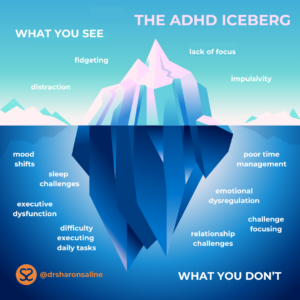The ADHD Iceberg Explained: Hidden Symptoms, Challenges and Strategies
“ICEBERG! Right ahead!!!”
Perhaps you remember this famous line from the iconic 1997 movie, “Titanic”, starring Leonardo DiCaprio and Kate Winslet. The ship’s captain alerted the passengers and crew of the historic vessel that they would soon strike a nearby iceberg that had been largely invisible, with 90% of the hulking iceberg being obscured underwater.
Within 30 seconds of sighting the iceberg, the ship made impact, sending the passengers and crew scrambling for safety amid the frigid waters. Had they been able to see more than just 10% of the iceberg – what was hidden below the surface – and adjust their course, disaster might have been averted. 
While certainly an excellent scene in the movie, the lessons learned from the ship’s collision with the iceberg are also a glimpse into the visible and invisible challenges of ADHD. The tip of the iceberg – the 10% we can see – represents behaviors and symptoms that are characterized as being “external”; meanwhile, the largest portion of the iceberg (what we can’t see) – represents those hidden symptoms and challenges that go unseen, characterized as being “internal”.
To celebrate ADHD Awareness Month, I’d like to explore the less visible ways ADHD impacts our lives and relationships. Let’s break down the ADHD Iceberg (first coined and depicted by Chris A. Ziegler Dendy) and how to manage it. You’ll be able to avoid unforeseen dangers and have smoother sailing.
The Iceberg We Can See – The External
Externalizing behaviors are frequently seen in the classroom, at the workplace and at home. They are easily observable and measurable, typically manifesting in inattention, impulsivity, and hyperactivity. They are related to conscious executive functioning skills such as verbal, behavioral and emotional impulse control, organization, time management, initiation and prioritizing. In children and teens, we see this tip of the ADHD more in boys than girls in common behaviors such as fidgeting, talking too much, interrupting others, moving around the classroom and physical aggression.
In adults, externalizing behaviors can manifest as missed deadlines, trouble with finances, tardiness, disorganized living spaces, difficulty remembering important dates or events, interrupting others, talking too much, job instability and strained relationships.
The Iceberg We Can’t See – The Internal
Internalizing ADHD behaviors are characterized as being less observable to others and frequently rely on someone’s self-report of their challenges in managing them.  These internal traits include a restless or wandering mind, low self- esteem, distractibility, inability to sustain attention, trouble with shifting or flexibility, overwhelm, limited self-awareness, poor working memory and shame.
These internal traits include a restless or wandering mind, low self- esteem, distractibility, inability to sustain attention, trouble with shifting or flexibility, overwhelm, limited self-awareness, poor working memory and shame.
Both types of these challenges exist in some form for everybody with ADHD. What’s under the surface of the water often shows up in combination with anxiety or depression, especially in girls and women with inattentive ADHD. Since these traits are less disruptive in a classroom, girls are less likely to be referred by educators which accounts for why women are one of the largest groups seeking ADHD diagnoses today. Dealing with all of these issues requires patience, sensitivity, and a genuine desire to understand the “whole person.”
Masking and the ADHD Iceberg
When the symptoms of ADHD remain hidden within the ADHD iceberg model, people rely on a coping response called “masking.” Both children and adults can engage in masking behaviors. Masking allows the person to conceal how their condition affects and limits their functioning.
ADHD masking is about conforming to neurotypical standards to avoid the shame and stigma related to being neurodivergent. It typically develops as a coping tool in childhood that continues into adulthood even though it may no longer be useful. Over time, masking becomes tough to maintain and prevents people from sharing who they really are.
The Consequences of Masking and the Unseen ADHD Iceberg
“I appear very organized to the outside world, but only because I spend an immense amount of time and energy putting everything together.” Cady, age 36
Masking with ADHD, while initially useful, may actually delay or sabotage a formal diagnosis and inadvertently foster the development of mental health issues such as anxiety or depression. Keeping symptoms of ADHD submerged and pretending they don’t exist to the outside world takes a great deal of energy. Diagnosed individuals who knowingly hide their challenges often worry profusely about being exposed and fear potential rejection or judgment.
Avoiding the unseen ADHD iceberg often exacerbates perfectionism and imposter syndrome. Going above and beyond, overpromising more than you can deliver and feeling overwhelmed in the process, you may hope to distract others from the inadequacy you deeply feel. In addition, years of intentional or unintentional masking can muddy one’s sense of self so you lose track of who you really are. Hiding the challenges of living with ADHD interferes with your ability to accept the brain you have, take pride in your strengths, and do more of what works.
4 Tips to Navigate the ADHD Iceberg
- Celebrate Strengths: Encouragement to focus on your strengths provides the space for you to be proud of who you are and embrace neurodiversity. It helps you to avoid the narrative that ADHD is something that bothers others, and should be hidden. It reduces the pressures to conform to others’ ideals. Some strengths of living with ADHD include: being energetic, spontaneous, enthusiastic, curious, creative, having quick thinking, being able to hyper-focus on what you love to do.
- Begin Journaling: Writing in a journal can help you process emotions and gain insight into your experiences. Your needs – and potential solutions – will become apparent as you consider these questions:
-
-
-
-
- If you weren’t masking, what else would you be doing?
- What obstacles or fears interfere with sharing your true self?
- How do your personal expectations help to maintain the submerged part of the ADHD iceberg?
- How can you make different, genuine choices in your behaviors or responses at home, at work or with friends?
-
-
-
3. Change Your Focus: Many people overcompensate for the deficits they think they have by overcommitting, overpromising, denial or avoidance. The negative self-talk that often accompanies masking can be shifted with paying attention to what is working. I recommend that you write or dictate three good things that happened in your day, ending with something you are grateful for each night before going to sleep. These positive items can be simple or complex. For example: 1) I wore my favorite shirt today; 2) I got the kids to school on time; 3) My boss liked my report. I’m grateful for the latte I had after lunch. This will take some practice but there’s research that shows this process really works.
4. Practice self-compassion. Treat yourself the way you would act with a close friend, a child or a beloved pet. Be kind, forgiving and understanding. Your masking developed to assist or protect you in the past but it may no longer be necessary. Hiding who you really are makes it impossible for you to obtain the assistance you need to be successful and share the wonderful parts of yourself with the world. Instead of judging yourself for being less than, cut yourself some slack. Put on your cloak of courage and learn to love your challenges instead of submerging them.

